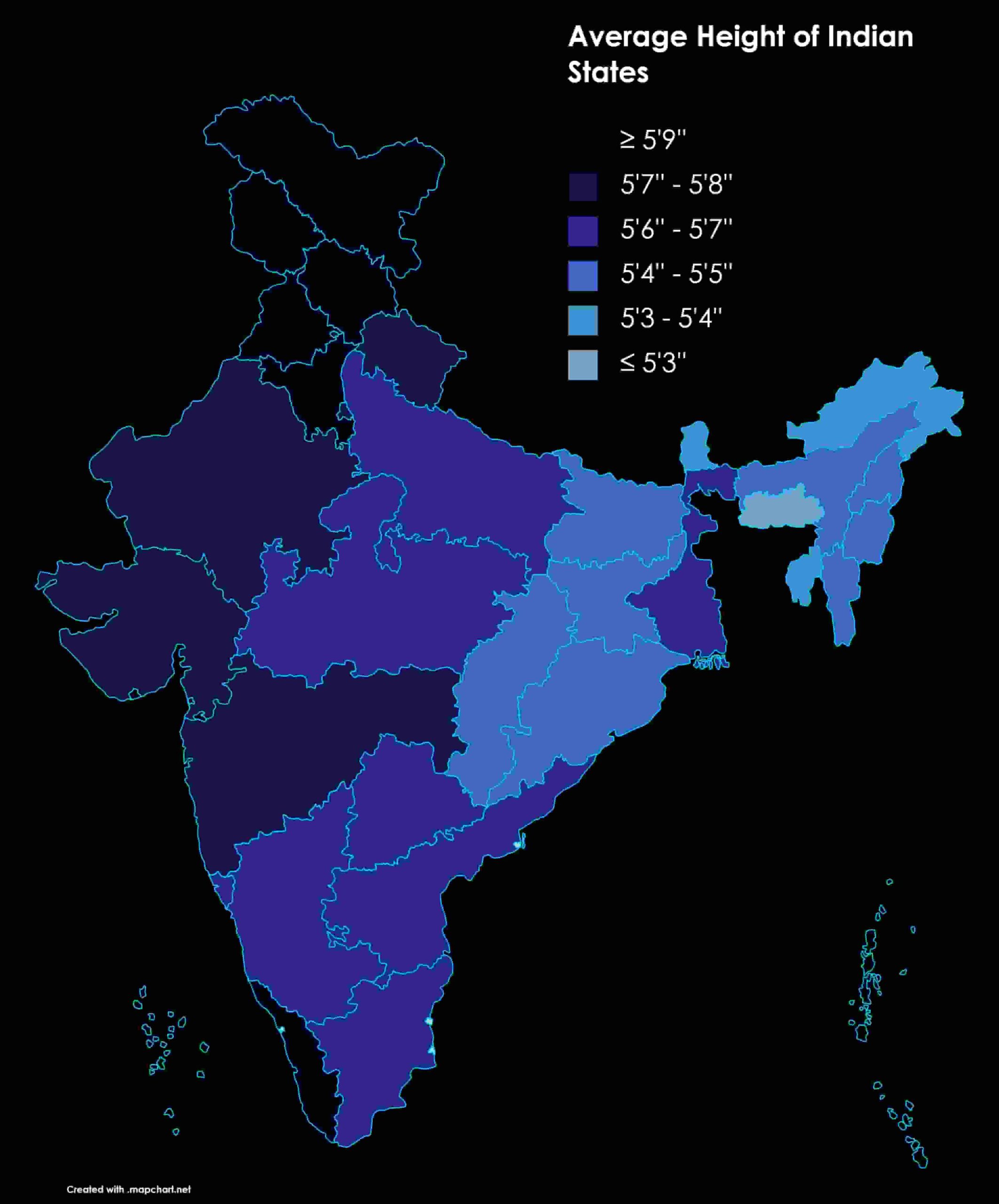The average height of person in India reflects a fascinating blend of genetic, nutritional, and lifestyle influences across this diverse country. Height variations are often shaped by the environment, diet, and socioeconomic factors, which play pivotal roles in determining growth patterns. Understanding these variations provides insight into both the average height for men in India and the average height for a woman in India, giving a clearer picture of height trends across various age groups.In this guide, we explore the average height of Indian male and female populations, delve into the contributing factors, and examine how lifestyle and environmental factors play a role in the height of Indian residents.
Table of Contents
ToggleWhat Is The Average Height Of Indian Residents?
The average height of person in India varies due to a wide range of genetic and lifestyle factors. For instance, the average height for Indian male is approximately 5 feet 8 inches (172 cm), while the average weight ranges between 65-75 kg. However, this can differ based on region, with men from northern states often being taller than those from the other areas due to dietary and environmental factors.
The average height of Indian female is around 5 feet 3 inches (160 cm), while her average weight is typically between 55-65 kg. Like men, women’s height and weight can vary based on nutrition and location.Indian men and women also see height variations based on their age groups. These figures reflect growth during formative years and gradual changes in stature that occur later in life, often due to lifestyle and health conditions.
Average Height For Women In India
Age Group | Average Height (cm) | Average Weight (kg) |
18-25 | 152-160 | 50-60 |
26-35 | 154-162 | 55-65 |
36-45 | 153-161 | 58-68 |
46-60 | 151-159 | 60-70 |
The average height for a woman in India changes subtly with age. Women in the age range of 18-25 typically range from 152-160 cm, while those in the 26-35 age group are often slightly taller. By the ages of 46-60, height may decrease due to natural aging processes, which is often reflected in national averages.
Average Male Height Of India
Age Group | Average Height (cm) | Average Weight (kg) |
18-25 | 167-172 | 60-70 |
26-35 | 168-173 | 65-75 |
36-45 | 167-172 | 68-78 |
46-60 | 165-170 | 70-80 |
The average height of Indian male residents typically peaks in young adulthood. Men aged 18-25 usually measure between 167-172 cm, while those aged 26-35 may reach slightly taller averages of 168-173 cm. Like women, men experience a gradual decline in height around ages 46-60, which can be attributed to changes in bone density and posture over time.
Factors Affecting Height In India
Several factors influence the average height of a person in India. Nutritional intake, genetics, and socioeconomic conditions are among the most impactful. Additionally, access to healthcare, lifestyle habits, and physical activity levels all play a part in determining overall growth and height.While genetics establish a foundation for height potential, factors such as nutrition and health during childhood and adolescence have a substantial impact on reaching this potential. Let’s explore how these factors affect height development in India.
Nutritional Factors Influencing Height In India
Proper nutrition is essential for achieving optimal height. In India, access to nutritious food can vary widely, influencing the average height of Indian male and female populations. Adequate protein, calcium, and vitamins, especially during childhood, are crucial for bone development and growth. In communities where nutritional deficiencies are common, average height tends to be lower due to limited growth potential.Regions with higher access to balanced diets and fortified foods often see taller average heights. Conversely, malnutrition or lack of essential nutrients during critical growth periods can stunt growth, affecting the average height for men in India and women alike.
The Role Of Genetics And Environment In Indian Height
Genetics and environmental factors together shape the average height of Indian residents. Genetic predisposition often determines the upper potential for height, while environmental influences—such as access to clean water, healthcare, and exposure to pollution—either support or inhibit growth.In India, genetic diversity across various ethnic groups leads to regional height variations. For instance, people from certain northern states tend to be taller on average compared to those from other regions. However, improved access to healthcare and nutrition can also enable individuals to reach closer to their genetic potential, even in areas historically associated with shorter statures.
Regional Variations In Average Height Across India
Height can differ significantly across India’s diverse regions, reflecting a mix of genetics, diet, and lifestyle. Northern states like Punjab and Haryana often report taller averages for both men and women due to a combination of genetic factors and diets rich in dairy and protein. In contrast, some southern and eastern regions have traditionally reported lower averages, though this gap has been decreasing with improved nutrition and healthcare.Such regional diversity highlights the unique blend of factors that contribute to the average height for Indian men and women across the country.
How Health And Lifestyle Choices Influence Height In India
Health and lifestyle choices significantly impact the average height of Indian male and female populations, especially in childhood and adolescence. Regular physical activity, proper sleep, and a balanced diet contribute to better growth potential. On the other hand, habits such as smoking or excessive stress can negatively influence bone health, potentially stunting growth.In recent years, increased awareness around health and fitness has encouraged better lifestyle choices, which may contribute to gradual increases in average height of Indian female and male residents. Improved healthcare, immunization, and access to medical facilities are also crucial, as they allow children to grow without the hindrances of preventable illnesses.
The Impact of Physical Activity on Height
Engaging in physical activity during formative years can positively affect growth, enhancing both bone density and muscle development. Activities such as stretching exercises, swimming, and sports contribute to improved posture and strength, which can positively influence the average height for men in India and women alike. Physical activity also promotes the release of growth hormones, which play a critical role in height development during childhood and adolescence.Additionally, active lifestyles help counteract potential height loss in older adults by maintaining bone health, thereby preserving height well into middle and later ages.
Conclusion: Understanding the Average Height of Indians
The average height of a person in India reflects a complex mix of genetics, nutrition, and lifestyle factors, each contributing uniquely to height trends across the country. With advancements in healthcare, nutrition, and growing awareness of healthy lifestyle choices, the average height for Indian men and women is likely to see gradual improvements over time.By understanding these influencing factors, individuals can make informed choices to support optimal growth, particularly during critical growth stages in childhood and adolescence. This evolving trend towards healthier living may help future generations in India reach their full height potential.


